What is user testing?
User testing is a research method that involves observing and analyzing user behavior while they interact with a product, website, or app. It's a way to understand how users interact with your design and the problems they encounter along the way. User testing can be done in a variety of ways, from in-person sessions to remote testing, and can include tasks such as completing a purchase, finding information, or navigating a website. The goal is to gather feedback on the user experience and identify areas for improvement.
User testing can also include surveys, questionnaires, and interviews to gather feedback from users on their experience. These methods can help you understand the user's thoughts, feelings, and opinions on your design, and can provide insights into how you can improve the user experience.
The importance of user testing in UX design
User testing is essential for successful UX design for several reasons. First, it helps you identify usability issues and areas of confusion that may hinder the user's journey. By observing real users interacting with your design, you can see where they get stuck, where they become frustrated, and where they abandon the process altogether. This feedback can help you make changes to your design that will improve the user experience and increase engagement.
Second, user testing can help you identify areas where your design is working well. By observing how users interact with your design, you can see where they are successful and where they find the experience enjoyable. This feedback can help you reinforce these positive aspects of your design and build on its strengths.
Finally, user testing can help you understand your users' needs and preferences. By gathering feedback from real users, you can identify patterns in their behavior and preferences. This feedback can help you make informed design decisions that meet the needs of your users and ultimately lead to a more successful product.
Common misconceptions about user testing
There are several common misconceptions about user testing that can prevent designers and developers from incorporating it into their design process. One of the most common misconceptions is that user testing is expensive and time-consuming. While it's true that user testing can be costly, there are many affordable options available, such as remote testing and online surveys. And while user testing does require time and effort to set up and conduct, the insights gained from the process can save time and resources in the long run by identifying and addressing usability issues early on.
Another common misconception is that user testing is only necessary for complex products or apps. In reality, user testing can be beneficial for any product or website, regardless of its complexity. Even simple designs can benefit from user testing by identifying areas for improvement and gathering feedback on the user experience.
How to conduct user testing
User testing can be conducted in a variety of ways, depending on your budget, timeline, and goals. Here are some common methods for conducting user testing:
In-person testing
In-person testing involves bringing users into a physical location to interact with your product or website. This method allows you to observe users directly and ask questions in real-time. In-person testing can be more expensive and time-consuming than other methods, but it provides valuable insights into the user experience.
Remote testing
Remote testing involves conducting user testing online, without the need for users to be physically present. This method can be more affordable and convenient than in-person testing, and can be conducted with users from anywhere in the world. Remote testing can involve screen sharing, video conferencing, or online surveys.
A/B testing
A/B testing involves creating two versions of your design and testing them with different groups of users to see which one performs better. This method allows you to test specific design elements and make data-driven decisions based on user feedback.
Analytics testing
Analytics testing involves analyzing user behavior data to identify patterns and trends in user behavior. This method can provide valuable insights into the user experience and help you make informed design decisions.
Analyzing and interpreting user testing results
Once you've conducted user testing, it's important to analyze and interpret the results to make informed design decisions. Here are some tips for analyzing and interpreting user testing results:
Look for patterns
Look for patterns in user behavior and feedback. Are there common pain points or areas of confusion that multiple users encountered? Identifying patterns can help you prioritize areas for improvement.
Pay attention to user feedback
Pay attention to user feedback, both positive and negative. Users may provide valuable insights into the user experience that you hadn't considered.
Compare results to your design goals
Compare the results of user testing to your design goals. Are you meeting your goals, or do you need to make changes to your design to better align with your goals?
Incorporating user testing results into UX design
Once you've analyzed and interpreted user testing results, it's time to incorporate those results into your UX design. Here are some tips for incorporating user testing results:
Prioritize changes
Prioritize changes based on the feedback you received from users. Focus on the areas that will have the biggest impact on the user experience.
Iterate and test again
Iterate on your design and conduct user testing again to see if your changes have had the desired effect. This process can help you continue to improve the user experience over time.
Involve stakeholders
Involve stakeholders in the design process and communicate the results of user testing. This can help build buy-in and support for your design decisions.
Tools for user testing
There are many tools available for conducting user testing, from simple online surveys to in-depth analytics platforms. Here are some popular tools for user testing:
UserTesting
UserTesting is a platform for conducting remote user testing. It allows you to create tasks for users to complete and provides video recordings and feedback on their experience.
Hotjar
Hotjar is an analytics platform that provides heatmaps, session recordings, and user feedback to help you understand user behavior.
SurveyMonkey
SurveyMonkey is a platform for creating and conducting online surveys. It can be used to gather feedback from users on their experience.
Examples of successful user testing
User testing has been instrumental in the success of many popular products and apps. Here are some examples of successful user testing:
Slack
Slack conducted extensive user testing during the development of its messaging app. User testing helped identify the need for features such as emoji reactions and the ability to customize notifications.
Airbnb
Airbnb conducted user testing to identify pain points in the booking process and make changes to improve the user experience. User testing led to changes such as simplifying the search process and adding a photo carousel for listings.
Dropbox
Dropbox conducted user testing to identify areas where users were getting stuck and frustrated. User testing led to changes such as simplifying the sign-up process and adding a tutorial for new users.









